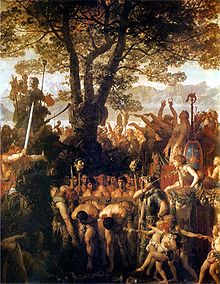- Tigurini
-
The Tigurini were a pagus (clan or tribe) of the Celtic Helvetii.[1] They crossed the Rhine together with the Helvetii to invade Gaul in 109 BC.[2] They moved south to the Roman region of Provence in 107 BC and defeated a Roman army under Lucius Cassius Longinus near Agen.[3][4]
After 103 BC, the Tigurini settled north of Lake Leman in the Jura mountains.[5]
In 58 BC, wishing to settle in the rich land of the Santoni, the Tigurini and the Helvetii encountered the armies Julius Caesar, but were defeated and massacred in the Battle of the Arar and the Battle of Bibracte, leaving 228,000 dead.[6] These battles were the initial events in the Gallic Wars, fought between 58 and 49 BC.
In Zurich, Calvin wrote the Consensus Tigurinus in 1549.[7]
The 17th century Swiss gunfounder Jean-Jacques Keller, in the service of the French Crown, called himself "Kelleri Tiguro" (i.e. "Of Keller the Tigurini").
See also
Notes
Belgica 

Celtica Abrincatui Aedui · Ambarri · Andes (Andecavi) · Arverni · Baiocasses · Bituriges Cubi · Cadurci · Caletes · Carnutes · Caturiges · Cenomani · Curiosolitae · Diablintes · Eburovices · Esuvii · Gabali · Helvetii · Lemovici · Lexovii · Lingones · Meldi · Namnetes · Nitiobriges · Osismii · Parisii · Petrocorii · Pictones · Redones · Ruteni · Santones · Senones · Segusiavi · Sequani · Tricasses · Turones · Unelli · Vellavi · Veneti · ViducassesAquitania Narbonensis Allobroges · Arecomici · Cavares · Caturiges · Ceutrones · Deciates · Helvii · Nantuates · Salluvii · Volcae (Arecomici and Tectosages) · Tricastini · VocontiiPart of: Celtic tribes in Europe Categories:- Ancient Gaul
- Helvetii
Wikimedia Foundation. 2010.


